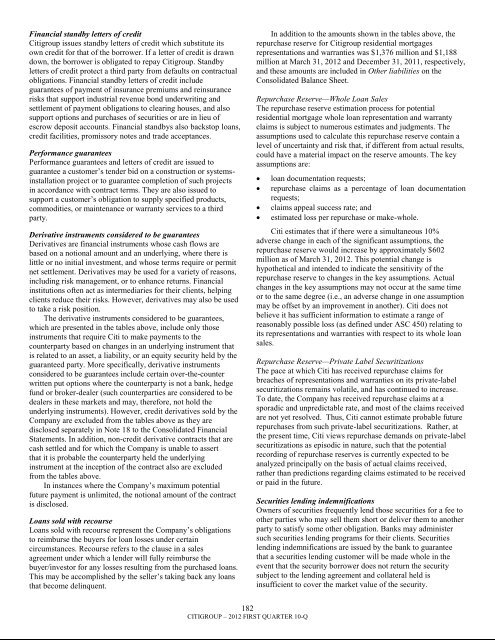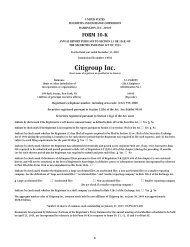7.3 billion - Citigroup
7.3 billion - Citigroup
7.3 billion - Citigroup
Create successful ePaper yourself
Turn your PDF publications into a flip-book with our unique Google optimized e-Paper software.
Financial standby letters of credit<strong>Citigroup</strong> issues standby letters of credit which substitute itsown credit for that of the borrower. If a letter of credit is drawndown, the borrower is obligated to repay <strong>Citigroup</strong>. Standbyletters of credit protect a third party from defaults on contractualobligations. Financial standby letters of credit includeguarantees of payment of insurance premiums and reinsurancerisks that support industrial revenue bond underwriting andsettlement of payment obligations to clearing houses, and alsosupport options and purchases of securities or are in lieu ofescrow deposit accounts. Financial standbys also backstop loans,credit facilities, promissory notes and trade acceptances.Performance guaranteesPerformance guarantees and letters of credit are issued toguarantee a customer‘s tender bid on a construction or systemsinstallationproject or to guarantee completion of such projectsin accordance with contract terms. They are also issued tosupport a customer‘s obligation to supply specified products,commodities, or maintenance or warranty services to a thirdparty.Derivative instruments considered to be guaranteesDerivatives are financial instruments whose cash flows arebased on a notional amount and an underlying, where there islittle or no initial investment, and whose terms require or permitnet settlement. Derivatives may be used for a variety of reasons,including risk management, or to enhance returns. Financialinstitutions often act as intermediaries for their clients, helpingclients reduce their risks. However, derivatives may also be usedto take a risk position.The derivative instruments considered to be guarantees,which are presented in the tables above, include only thoseinstruments that require Citi to make payments to thecounterparty based on changes in an underlying instrument thatis related to an asset, a liability, or an equity security held by theguaranteed party. More specifically, derivative instrumentsconsidered to be guarantees include certain over-the-counterwritten put options where the counterparty is not a bank, hedgefund or broker-dealer (such counterparties are considered to bedealers in these markets and may, therefore, not hold theunderlying instruments). However, credit derivatives sold by theCompany are excluded from the tables above as they aredisclosed separately in Note 18 to the Consolidated FinancialStatements. In addition, non-credit derivative contracts that arecash settled and for which the Company is unable to assertthat it is probable the counterparty held the underlyinginstrument at the inception of the contract also are excludedfrom the tables above.In instances where the Company‘s maximum potentialfuture payment is unlimited, the notional amount of the contractis disclosed.Loans sold with recourseLoans sold with recourse represent the Company‘s obligationsto reimburse the buyers for loan losses under certaincircumstances. Recourse refers to the clause in a salesagreement under which a lender will fully reimburse thebuyer/investor for any losses resulting from the purchased loans.This may be accomplished by the seller‘s taking back any loansthat become delinquent.In addition to the amounts shown in the tables above, therepurchase reserve for <strong>Citigroup</strong> residential mortgagesrepresentations and warranties was $1,376 million and $1,188million at March 31, 2012 and December 31, 2011, respectively,and these amounts are included in Other liabilities on theConsolidated Balance Sheet.Repurchase Reserve—Whole Loan SalesThe repurchase reserve estimation process for potentialresidential mortgage whole loan representation and warrantyclaims is subject to numerous estimates and judgments. Theassumptions used to calculate this repurchase reserve contain alevel of uncertainty and risk that, if different from actual results,could have a material impact on the reserve amounts. The keyassumptions are:loan documentation requests;repurchase claims as a percentage of loan documentationrequests;claims appeal success rate; andestimated loss per repurchase or make-whole.Citi estimates that if there were a simultaneous 10%adverse change in each of the significant assumptions, therepurchase reserve would increase by approximately $602million as of March 31, 2012. This potential change ishypothetical and intended to indicate the sensitivity of therepurchase reserve to changes in the key assumptions. Actualchanges in the key assumptions may not occur at the same timeor to the same degree (i.e., an adverse change in one assumptionmay be offset by an improvement in another). Citi does notbelieve it has sufficient information to estimate a range ofreasonably possible loss (as defined under ASC 450) relating toits representations and warranties with respect to its whole loansales.Repurchase Reserve—Private Label SecuritizationsThe pace at which Citi has received repurchase claims forbreaches of representations and warranties on its private-labelsecuritizations remains volatile, and has continued to increase.To date, the Company has received repurchase claims at asporadic and unpredictable rate, and most of the claims receivedare not yet resolved. Thus, Citi cannot estimate probable futurerepurchases from such private-label securitizations. Rather, atthe present time, Citi views repurchase demands on private-labelsecuritizations as episodic in nature, such that the potentialrecording of repurchase reserves is currently expected to beanalyzed principally on the basis of actual claims received,rather than predictions regarding claims estimated to be receivedor paid in the future.Securities lending indemnificationsOwners of securities frequently lend those securities for a fee toother parties who may sell them short or deliver them to anotherparty to satisfy some other obligation. Banks may administersuch securities lending programs for their clients. Securitieslending indemnifications are issued by the bank to guaranteethat a securities lending customer will be made whole in theevent that the security borrower does not return the securitysubject to the lending agreement and collateral held isinsufficient to cover the market value of the security.182CITIGROUP – 2012 FIRST QUARTER 10-Q
















